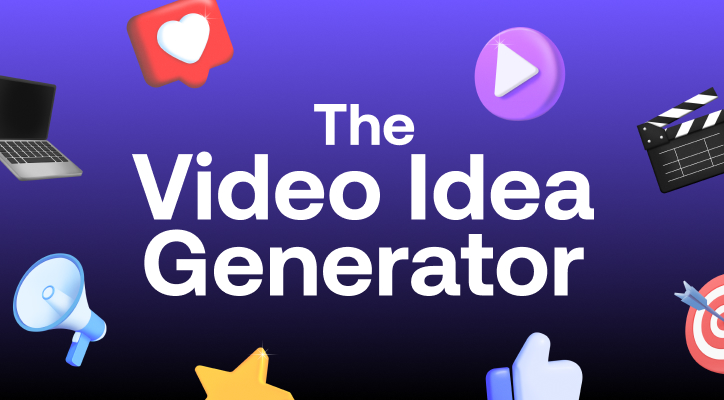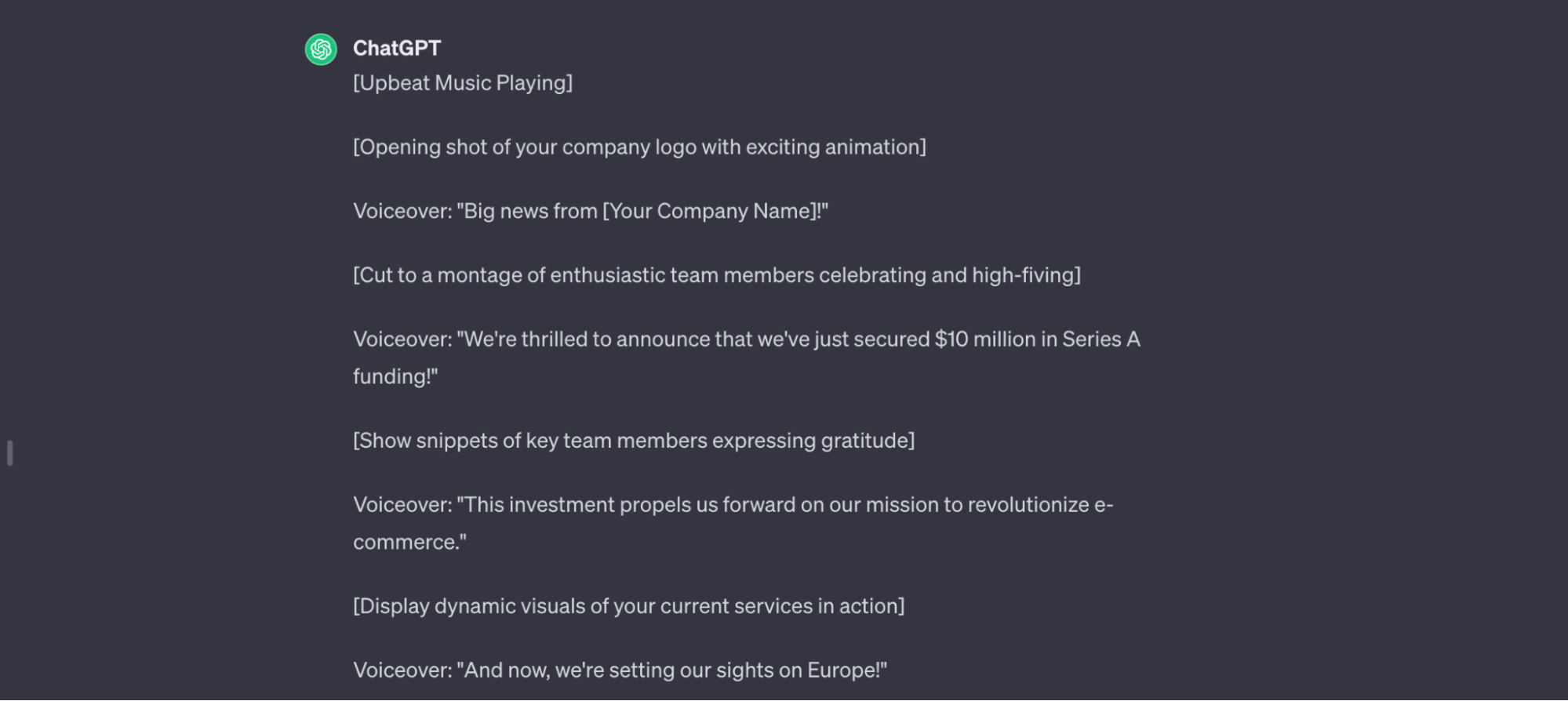You've decided to invest in video content for your brand, but you're not sure what options you have.
Then it's a good thing you found this piece. In this article, we'll discuss five types of branded video content you must include in your video marketing strategy.
We'll also show you how to distribute branded video content for improved results.
What is branded video content?
A branded video is any video content — whether it's a few seconds long or goes on for hours — that helps your target audience learn more about your brand. It relies on the perceived identity of your company thanks to your brand book.
It could be a promotional video for your latest product, a documentary about your new CSR initiative, a brand launch video or something else. What matters is that it puts your brand front and center and communicates some or all of your video content ideas to your audience.
5 types of branded video content for success
While brand videos are the most effective to raise awareness, they aren’t a one-way street. There are many ways to tell your brand’s story, engage your audience, and leave a positive impression on your business with video content.
1. Origin story video content
This type of branded introduction video explains your brand’s history. It helps your target audience and actual customers understand the mission and vision, plus the problem you’re trying to solve.
There are several ways to execute this type of branded video campaign. You could have a video featuring simple, first-person dialogue from the company’s CEO or founder, like Nadam does here. Or experiment with a more creative setup like Lego’s animated documentary.
What matters is that the brand storytelling is clear, straight to the point, and compelling enough to strengthen your brand’s connection with the target audience.
2. Customer stories
Two out of three participants in Wyzowl’s Testimonial Content survey said that they are more likely to make a purchase after watching a customer testimonial video demonstrating how a business, product, or service helped another person like them.
Customer stories typically follow the problem-solution-result structure. This means they open with the customer highlighting the problem they were trying to solve, then transition to why they chose your brand as the solution before closing with the positive impact of your product or service on their business. A good example is this testimonial video from Cred.
But that isn’t the only way to tell customer stories. Take Thread’s customer story, for example. Instead of diving right into the problem the company was trying to solve, the case study starts by showing off Thread’s culture and employees. It combines first-person narration with behind-the-scenes footage of the company’s day-to-day activities.
3. Product videos
These are educational videos that help customers understand and succeed with your product. They explain features, use cases, hacks, and so much more to help customers make the most of your product.
Common examples include:
- Product demo videos that serve as sales collateral and highlight your product’s core features plus offerings. Here’s an example from Amplitude.
- Walkthroughs and explainer videos that show users how to complete a specific action with your product. A good example is this video showing how to use PlayPlay’s dynamic elements feature.
- Help videos that explain how to troubleshoot and resolve specific issues independently. Take this video from Shopify’s help center, for example.
The language used in a product video should be simple, with well-paced transitions to make it easy for the viewer to follow.

Want to explore further into brand product video creation?
4. Company announcements
These videos are used to share milestones with your target audience and customers. They help you keep your audience up to speed with your latest decisions and developments and how these things affect them.
Take Meta, for example. When the company rebranded to Meta from Facebook, it shared a branded content where the founder shared the company's vision, the reason for the rebrand, and what the future of the business looks like.
When sharing these important milestones and results, it’s best to have a first-person video that focuses on your founder or a top C-level official who stands as the head of the business to address the target audience and customers.
5. Employer branding videos
These are company culture videos that position your business as a great place to work. They help you organically attract qualified candidates for open roles — without investing a ton of resources into job board placements.
There are different types of employer branding videos you can incorporate into your branded video strategy.
- Roundups: These videos share a recap of your company’s activities over a specific period, like a quarter or month. It’s a great way to share interesting highlights like product updates, CSR activities, and employee milestones. Here’s a quarterly recap video from PlayPlay.
- A day in my life: These videos show what an employee's typical day looks like in your organization. It sometimes highlights what the employee does outside of work, especially when you showcase your company’s work-life balance culture. Here’s an example from Meta.
- New hire introductions: These videos give new employees an opportunity to introduce themselves to team members and your target audience. They’ll talk about their work experience, why they joined your company, and what their life looks like outside of work. Oktopost does this really well with this video. Note that this can also take the interview video format.

Do you want to learn more about employer branding strategy ? :
How to create branded video content
Whether you’re creating an employer brand video or a customer case study, you’ll need to follow these fundamental steps to create the best brand video.
1. Choose the type of branded video you want to create
The type of branded video you want determines your approach to the video creation process.
While the basics of creating a branded video are the same, the nuances differ depending on your video type. For example, writing a case study video script is pretty different from writing one for an employer branding video. The same applies to the video concept or even the budget.
So how do you choose the right type of branded video? It comes down to why you want to create a branded video in the first place.
Let's say your company closed a significant investment. In that case, you'll want to share the milestone with the public via a company announcement video. On the other hand, if you're looking to recruit A+ candidates for your growing team, then you need an employer branding video.
2. Choose whether to outsource or produce the video in-house
You’ll need to decide who will be in charge of planning and executing the video production. This decision comes down to three main things:
Expertise
Is there an employee who has experience producing the type of video required? If yes, then you can keep things in-house. If not, consider hiring a professional freelancer or video production company to handle your project.
Before you make your final decision however, consider the points below, where we show you in-house video creation is simpler than you think!
Bandwidth
Let’s say you have an in-house pro handling all your video needs. Does that person have the time to take on a new creative project? Or are they stretched and overburdened by pending tasks? If the latter is the case, consider outsourcing production to save time.
Budget
Data from Clutch shows that most video production agencies charge between $100 to $150 per hour, with larger agencies charging $200,000 or more per project. That’s quite the investment!
If you have a small budget, it’s best to handle the video production process internally. There are many ways to produce professional branded videos without breaking the bank.
For example, you can shoot the video on a smartphone instead of buying a fancy camera. You can also choose a simple creative direction that requires minimal financial investment to bring to life.
PlayPlay can help if no one on your team is skilled enough to produce branded videos. It’s a video software that anyone — really anyone — can use to make professional branded videos.
Check out this walkthrough video showing you how to create a video with PlayPlay in five minutes!
3. Set the creative direction
The creative direction is how you'll deliver your video's core message or theme. It involves the following:
- Coming up with a compelling story that captures your audience’s attention and passes your message across clearly. Let’s say you’re creating a company rebrand video. In that case, you could have a brand narrative story that talks about your company’s past, the present, and what the future looks like with the rebrand.
- Choosing a video format — whether that's animation, featuring human characters, or something else.
- Picking video elements like color, background music, transitions, and the like.
- Choosing a narrative technique — whether it should be in first or third-person — Whether it should be emotional storytelling or factual.
- Picking the video set(s), if required.
It’s a lot easier to plan for the actual video production once you’ve gone through the above steps. Say your video will feature human characters; you’ll be able to select these people ahead of time and inform them of the project details.
4. Write a script
The video script breaks down the creative direction into an easy-to-follow blueprint to guide the video production.
Without it, the production process becomes spontaneous, and things will go out of scope. The last thing you want is to produce a video that veers off the intended theme or misses important set details.
A good video script is:
- Easy to understand: It avoids unnecessary jargon and overly complex language that might confuse people on set and the audience.
- Has clear visual directions: A good video script doesn't just focus on the spoken words; it also considers the visual elements. Describe the visuals, scenes, and actions that will complement the script. Think about camera angles, transitions, and any on-screen text or graphics that will enhance your audience’s experience.
- Tells one story: It focuses on one idea from the beginning to the end. It doesn’t lump multiple ideas into a single narrative.
With AI tools like ChatGPT, it’s never been easier to create good video scripts. Input a prompt describing your story and other video elements into the chatbot, and it will give you a video script first draft that you can clean up for production.
For example, we gave ChatGPT the following prompt:
My SaaS company just raised $10 million in Series A funding. We’ll use this money to expand our e-commerce services to Europe. Write a 30-second video script announcing the funding and our plans.
And we got this:
Interested in using AI for video scripts?
Check out our recent article on how to create a video script with ChatGPT now.
Check it out 5. Record and edit the video
It’s time to bring your video to life. The exact process depends on your video’s creative direction, especially the format.
Let’s say you’re creating an animated video. In that case, you won’t need to shoot the video in a physical location. Instead, you'll need to record high-quality voiceovers. Do this by booking an audio studio or simply finding a quiet room and using a decent microphone to record.
After recording the raw video footage, the next step is to edit it for the final result. This is where you add video elements like transitions and subtitles. It also involves improving the audio and visual quality, removing background noise, and trimming the video footage to the ideal length.
PlayPlay works really well here. Once you import the raw footage into the app, you can add different elements like your logo, colors, voice-overs, subtitles, transitions, and the like to make the video fit for viewing.
How to distribute your branded video to increase ROI
Creating a high-quality brand introduction video is only one piece of the puzzle. To drive results, you need to distribute these videos on all channels where your audience hangs out.
Videos have more reach than other social media content formats. Take X (Twitter), for example: Posts with video get 10 times more engagement than those without video.
You can share your video as new social content or drive traffic to where it is already published. Here’s what we mean.
Let’s say you published an employer branding video on YouTube. You can post the same video on your other social accounts like LinkedIn and Instagram. Alternatively, you can publish a video snippet on these channels with a link to your YouTube channel where people can watch the full thing.
2. Do email marketing
Email marketing is the second most effective brand awareness channel, according to the Campaign Monitor Report.
You can feature your branded video in your weekly or monthly newsletter if you already have one. If you don't have one, you can send a one-off email to customers with a link to the video and a brief video description.
But only do this if you're sharing an important company update — like rebranding news, fundraising announcement, or change of guard. For example, there's no need to send a one-off email containing ”a day in my life” video from an employee.
3. Invest in influencer marketing
More than 33% of respondents in Linqia’s State of Influencer Marketing report said that influencer content outperforms branded content.
Partner with influencers in your niche to share your branded video with their audience. Platforms like Grin and CreatorIQ connect you with niche influencers that fit different budgets.
You can ask the influencer to publish the video on their channels for visibility. Or create new content where they talk about your video and then ask their audience to click the link to watch the video on your channels.
Scale your branded video strategy with PlayPlay
PlayPlay makes it easy for you to execute an effective branded video strategy.
With PlayPlay, you can create professional branded videos in minutes. PlayPlay provides customizable templates that you can tweak for your videos, so you don't have to start from scratch. And if you're an AI fan, you can use PlayPlay’s AI Video generator to create branded videos from simple prompts.
Don't just take our word for it. Get on board with a 7-day free trial and create your first branded video with our easy-to-use video maker.




